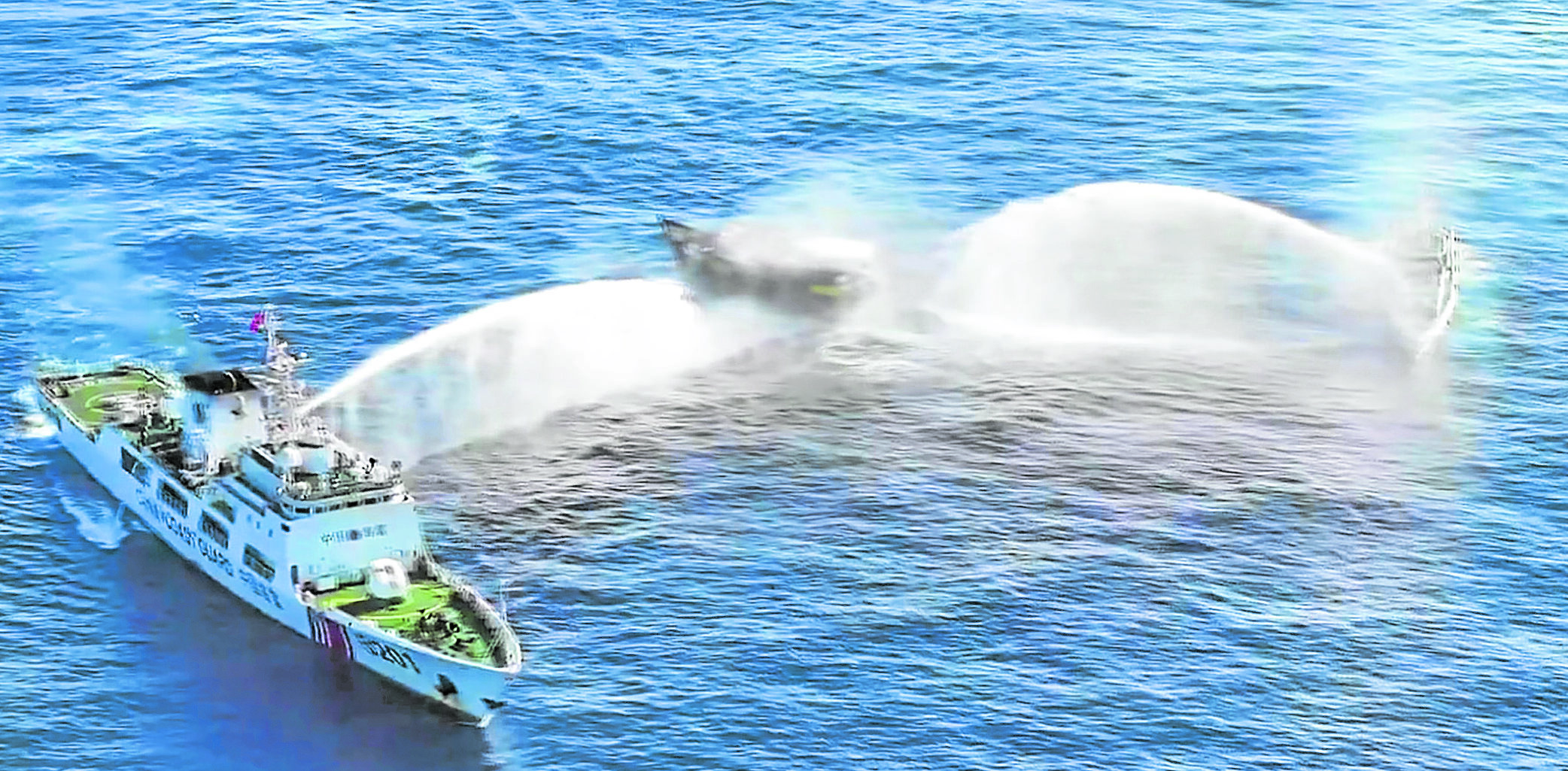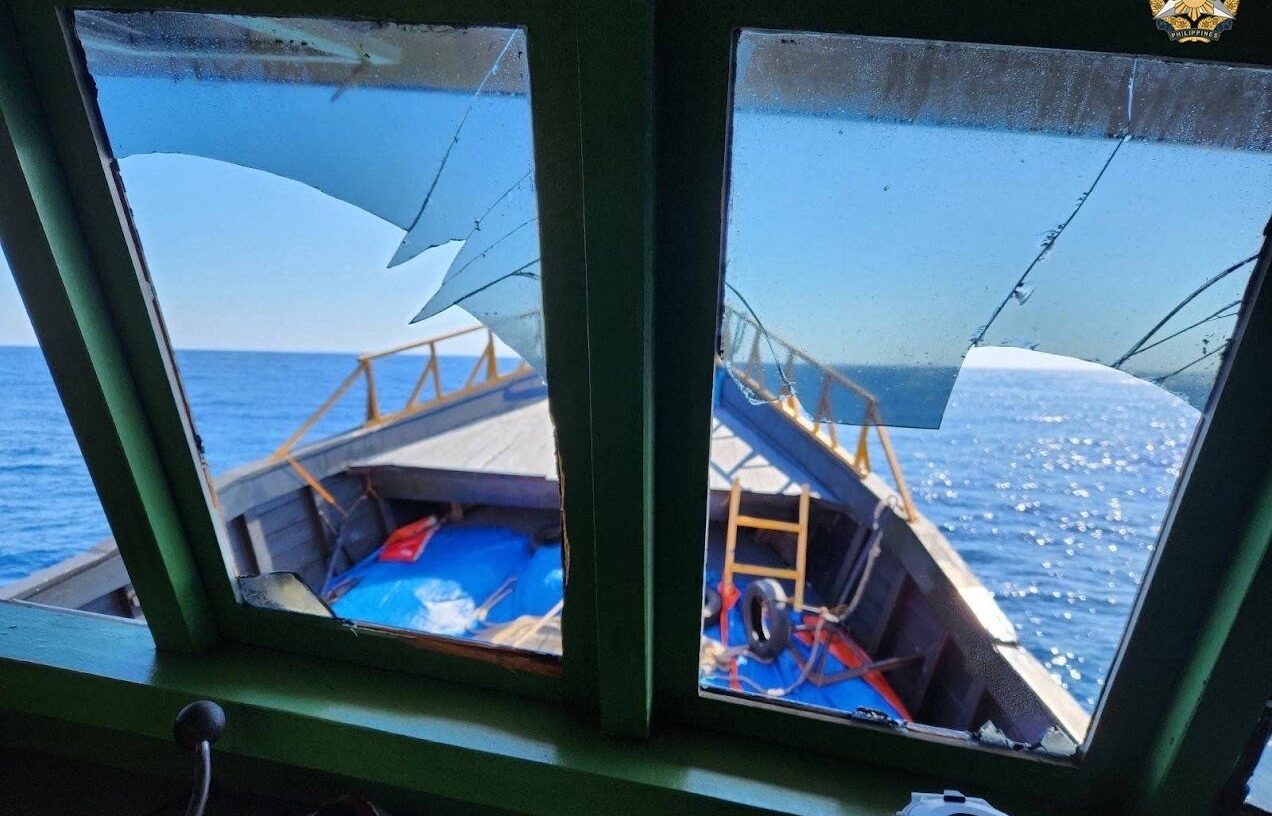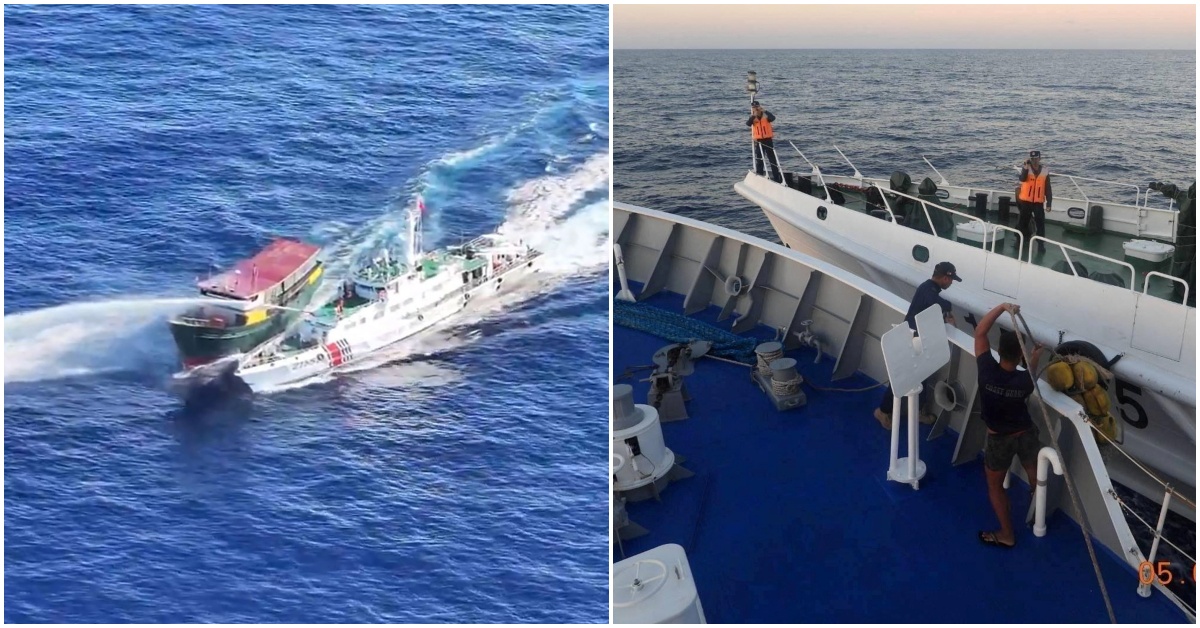PH tells China: Order ships to leave Ayungin

ASSAULT ON THE HIGH SEAS Manila has asked Beijing to order all its vessels to leave Ayungin Shoal following the “dangerous maneuvers” made by the China Coast Guard (CCG) to block Philippine ships headed for the BRP Sierra Madre on Tuesday. An image from aerial footage released by the Philippine Coast Guard shows two CCG vessels blasting their water cannons at Unaizah May 4 (center). —AFP
The Philippines summoned China’s second highest diplomat in Manila on Tuesday to demand that Beijing order all Chinese vessels to leave Ayungin (Second Thomas) Shoal in the West Philippine Sea, after their “dangerous maneuvers” resulted in a collision that damaged a Philippine Coast Guard (PCG) ship.
A water cannon attack by the Chinese also left four Filipino crew members injured in the latest escalation of conflict between the two countries during a routine Philippine trip to a remote outpost in Ayungin Shoal.
The Department of Foreign Affairs (DFA) said it called Deputy Chief of Mission Zhou Zhiyong of the Chinese Embassy to lodge Manila’s protest against the aggressive actions of the China Coast Guard (CCG) and Chinese maritime militias toward Philippine ships on a rotation and resupply mission (Rore) to Ayungin.
“During the meeting, the Philippines stressed, among others, that China’s interference with the Philippines’ routine and lawful activities in its own exclusive economic zone (EEZ) is unacceptable,” the DFA said in a statement.
READ: PH to China: Leave Ayungin Shoal immediately
“China’s actions in Ayungin Shoal infringe upon the Philippines’ sovereign rights and jurisdiction,” it added.
It wasn’t immediately clear why the DFA summoned the deputy chief of mission instead of Chinese Ambassador to the Philippines Huang Xilian.
Interviewed by an Australian broadcaster in Melbourne, where he was attending a regional summit, President Marcos warned that a “mistake” could lead to outright conflict in the South China Sea (SCS).
“The potential for outright conflict is much higher now than it was before,” Mr. Marcos told Australian Broadcasting Corp.’s “7:30” news program in an interview that aired on Monday, before the latest incident.
“[It] could come from not a strategic decision by anyone saying, ‘Okay, we’re going to war,’ but just by some servicemen making a mistake or some action that’s misunderstood,” he added.
Two of the Philippines’ major allies, the United States and Japan, issued statements on Tuesday condemning the “dangerous actions” in the disputed waters.
“The United States stands with the Philippines and proponents of international law in support of a free and open Indo Pacific,” US Ambassador MaryKay Carlson wrote on X (formerly Twitter).
The Embassy of Japan in Manila said Tokyo “reiterates its grave concern on the repeated dangerous actions in the SCS including the recent use of water cannon by CCG which resulted in Filipino injuries and a collision.”

DAMAGED BRIDGE A photo released by the Armed Forces of the Philippines shows the damage caused by the China Coast Guard’s water cannon blast on the Unaizah May 4.
In a statement on Tuesday night, the Chinese Embassy in Manila said the response of the CCG to the Philippine vessels was “professional, restrained, reasonable and lawful.”
The embassy said it made its own representations with the DFA to protest the “illegal trespassing on [the Spratly islands] by Philippine vessels.”
It claimed that the Philippine ships were the ones that intruded into China’s waters.
“[The Philippines] provoked incidents in the waters off [Ayungin], and seriously violated China’s territorial sovereignty and maritime rights and interests,” the embassy said.
“China once again urges the Philippines to stop maritime provocations and refrain from taking any actions that may complicate the maritime situation,” it warned.
‘Cannot be appropriated’
Among the Philippines’ demands during the meeting with Zhou was for Chinese vessels to leave the vicinity of Ayungin, a low-tide elevation that lies about 194 kilometers off Palawan province, well within the country’s 370-km EEZ.
Manila maintains its presence in Ayungin through the BRP Sierra Madre, a rusting World War II-era warship deliberately grounded in 1999. The outpost hosts a small contingent of Philippine troops, requiring regular Rore missions that have been on the receiving end of Chinese harassment, according to Philippine security officials.
The DFA asserted that Ayungin was within the Philippines’ EEZ and continental shelf.
Under the 1982 United Nations Convention on the Law of the Sea and the 2016 arbitral award, the shoal “cannot be appropriated for sovereignty claims,” the agency said.
According to a statement of the National Task Force on the West Philippine Sea (NTF-WPS), the CCG and Chinese maritime militia vessels “harassed, blocked, deployed water cannons, and executed dangerous maneuvers” against Philippine ships on Tuesday morning, in “another attempt to illegally impede or obstruct” their Rore mission.
At 8:15 a.m. a CCG vessel caused a minor collision with Unaizah May 4 (UM4), one of the civilian supply boats chartered by the Armed Forces of the Philippines, the task force said.
Navy personnel injured
It added that CCG vessels 21555 and 21551 simultaneously deployed water cannons at the UM4.
“The use of water cannons by the CCG vessels shattered the wind shield of UM4, causing minor injuries to at least four personnel on board,” the NTF-WPS said.
The crew members sustained wounds in their hands and various parts of their bodies. They were treated by PCG personnel aboard BRP Sindangan, one of the PCG vessels escorting the supply boats.
Earlier at 6:32 a.m., CCG vessel 21555 made “dangerous blocking maneuvers” against BRP Sindangan that led to a collision, which resulted in “superficial structural damage to the hull of the PCG vessel,” the task force said.
As a result of the damage to the vessel and injuries to crew, UM4, escorted by the BRP Sindangan, went back to mainland Palawan.
But Unaizah May 1, the other civilian supply boat, “successfully docked” at the Sierra Madre at 9:30 a.m. and left a little before 11 a.m., successfully completing its mission, the task force added.

TWO FORMS OF HARASSMENT A China Coast Guard (CCG) ship (left photo) trains its water cannon on the Philippine military-
chartered civilian boat Unaizah May 4 in an attempt to block the latter’s supply mission to Ayungin (Second Thomas) Shoal
in the West Philippine Sea on Tuesday. Earlier, the Philippine Coast Guard’s (PCG) BRP Sindangan was damaged after a collision
(right) with a CCG ship due to the latter’s “dangerous blocking maneuvers,” the PCG said. —PHOTOS FROMPCG
Commodore Jay Tarriela, PCG spokesperson for the West Philippine Sea, said the PCG vessels faced harassment throughout the resupply operation.
“Their reckless and illegal actions led to a collision” between BRP Sindangan and CCG vessel 21555 “that resulted [in] minor structural damage to the PCG vessel,” Tarriela said on X.
CCG ships exhibited similar behavior toward Philippine supply boats that resulted in collisions in the same waters in October and December last year. Three of the 14 Rore missions in 2023 were also hounded by water cannon attacks by China, the Navy spokesperson for the West Philippine Sea, Commodore Roy Vincent Trinidad, said in February.
China’s version
In China, however, there was a different version of events.
The state-run Chinese Global Times reported on Tuesday that the CCG “lawfully took control measures on Tuesday against a Philippine vessel illegally entering the waters adjacent to Ren’ai Jiao in the Nansha Islands.”
Ren’ai Jiao is China’s name for Ayungin, while Nansha Islands is what it calls the Spratly region, an area in the South China Sea with overlapping claims by the Philippines, China and other claimants. (See related story in World, Page A9.) —WITH REPORTS FROM REUTERS, INQUIRER RESEARCH AND DONA Z. PAZZIBUGAN in Melbourne INQ
For comprehensive coverage, in-depth analysis, visit our special page for West Philippine Sea updates. Stay informed with articles, videos, and expert opinions.
